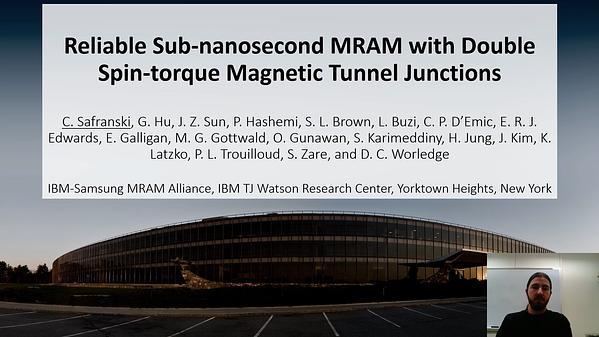Would you like to see your presentation here, made available to a global audience of researchers?
Add your own presentation or have us affordably record your next conference.
Magnetic skyrmions are recently attracting attention from the viewpoint of application to next-generation spintronics devices such as ultra-low-power Brownian computers. Skyrmions are expected to function as information carriers in those devices because of their unique features such as Brownian motion at near room temperature, small size, easy detection and easy control (1-4). In order to realize such devices, electrical gating and amplification of the skyrmion signal are indispensable. The primary mechanism of the voltage control technique for skyrmions is the voltage-controlled-magnetic-anisotropy effect (VCMA effect) (5-6). In the previous studies using the VCMA effect, for example, modulation of the diffusion coefficient (2) and creation/annihilation of the skyrmions (3) have been demonstrated. However, “skyrmion gates/transistors” have not been realized experimentally yet. Obstacles might be that the conditions creating skyrmions are easily affected by the local stress introduced from the gate fabrication. Furthermore, a non-negligible energy barrier that appears at the edge of the gate electrode, traps the skyrmions there. In this talk, we will present our attempts to realize a device in which skyrmions are not trapped at the edge of the gate electrode.
A skyrmion film consisting of Ta|Co16Fe64B20|Ta|MgO|SiO2 was deposited on a thermally oxidized silicon substrate by the magnetron sputtering. In order to apply voltage to the magnetic layer, thin Ru gate electrodes with a thickness of 2 nm were deposited onto this film, and the MOKE microscope observed the motion of skyrmions. Narrow gate electrodes trapped skyrmion at the edge of the electrodes even though no voltage was applied. The wider Ru electrode enables a free passage of the skyrmions through the edge. The result is one of the fundamentals of realizing the skyrmion transistors.
Acknowledgement: The authors acknowledge to Ono laboratory in Kyoto Univ. This research and development work was supported by ULVAC, Inc., JST CREST Grant number JPMJCR20C1, Japan and JSPS KAKENHI Grant Number JP20H05666.
References:
(1) J. Zázvorka et al., Nat. Nanotechnol., 14, 658–661 (2019),
(2) T. Nozaki et al., Appl. Phys. Lett., 114, 012402 (2019),
(3) M. Schott et al., Nano Letters., 17, 3006-3012 (2017),
(4) B. W. Walker et al., Appl. Phys. Lett., 118, 192404 (2021),
(5) M. Weisheit et al., Science 315, 349 (2007),
(6) T. Maruyama et al., Nature Nanotech., 4, 158 (2009),
(7) Y. Jibiki et al., Appl. Phys. Lett., 117, 082402 (2020)
